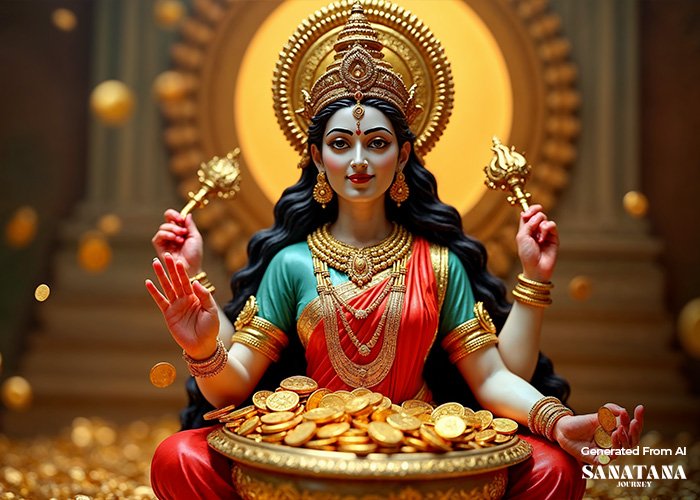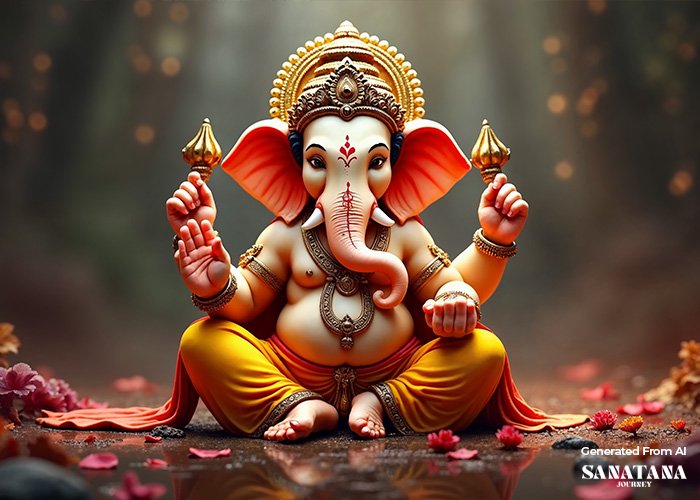

Deities & Devotion
Deities in Sanatana Dharma represent various aspects of the divine, each embodying unique qualities like wisdom, power, love, and protection. Devotion to these deities, expressed through rituals, prayers, and meditative practices, forms a deep bond between the devotee and the divine. Worshiping deities like Lord Shiva, Goddess Durga, Lord Vishnu, and many others allows individuals to seek blessings, guidance, and spiritual growth. Through devotion, one can experience inner peace, strength, and a profound connection to the sacred energy that pervades the universe. Explore the rich traditions of devotion and discover the divine in every aspect of life.
Lord Brahma
The Rig Veda explains Brahma as a mysterious sacred power that helped create the world. In Hindu mythology, Brahma is said to have been born from a golden egg or emerged as a boar who raised the earth from the waters. He is also linked to other forms, like a fish or tortoise, at the beginning of time. Another belief states he was born from a lotus sprouting from Vishnu’s navel. Brahma is depicted with four faces representing the Vedas and four hands holding a rosary, water-pot, book, and lotus. He is seated on a lotus and rides a swan, symbolizing results.


Lord Vishnu
In Hindu mythology, Lord Vishnu is known for his role in permanence, continuity, and preservation. He is part of the Trinity along with Brahma and Mahesh. Vishnu has numerous incarnations, including Lord Rama, Lord Krishna, and animal forms like Matsya (fish), Kurma (tortoise), and Varaha (boar), making up 24 incarnations. Vishnu is depicted with blue skin, four or more hands, and dressed in yellow. He holds a wheel symbolizing creation and destruction, a conch-shell representing the origin of existence, and a club denoting wisdom. His vehicle is Garuda, a half-man, half-bird creature.
Lord Shiva
Lord Shiva, part of the holy Trinity with Brahma and Vishnu, is known as the destroyer and a symbol of meditation and austerity. He is often depicted dwelling in the Himalayas and cremation grounds. Unlike Vishnu’s incarnations, Shiva is revered in many forms, including his Lingam form, symbolizing procreation and regeneration. His various aspects include Aghora, Ishana, and Tat Purush, among others. Shiva is three-eyed, with matted hair holding the Ganga, a crescent moon on his head, and a blue throat from drinking poison. He carries a trident, damru, axe, and antelope, and his vehicle is the bull, Nandi.
Festivals: Maha Shivratri


Lord Shri Rama
Lord Rama, the seventh incarnation of Lord Vishnu, is known as Purushottam, meaning the best of all men. He represents truth, morality, and is the ideal son, husband, and king. His life is depicted in the epics Ramayana and Ramcharitmanas. In Hindu tradition, narrations of Sri Rama Katha are held to inspire spirituality and guide people toward righteousness. Lord Rama is depicted with a dark complexion, holding a bow and arrow, often shown alongside his wife Sita and brother Lakshmana.
Festivals: Ram Navmi & Diwali
Lord Shri Krishna
Lord Krishna, the eighth incarnation of Vishnu, is a beloved figure in Hindu mythology, symbolizing childhood, adolescence, and adulthood. His playful nature and teachings are celebrated in the Srimad Bhagavata Mahapurana and the Bhagavad Gita. Hindu communities worldwide hold Shrimad Bhagwat Katha to share his legacy. Krishna is typically depicted with a blue or black complexion, playing the flute, and is often shown with gopis, enjoying butter, or as Arjuna’s charioteer in battle.


Goddess Durga
Before the cosmic creation, Goddess Durga emerged from Lord Shiva’s left half to inhabit Shivlok. She represents female energy and defeated the demon Mahishasura, who was terrorizing the earth. Believed to be a ray of energy from Lord Vishnu, she is also known as the ‘Shakti’ of the Impersonal Absolute. Durga is worshipped in nine forms during Durga Puja, including Kushmanda, Chandraghanta, and Mahakali. In Indian mythology, she is often considered the consort of Lord Shiva as Parvati. Goddess Durga is depicted with eight hands, holding various weapons and symbols, and is often shown seated in a yogic posture on a tiger or lion.
Festival: Janmashtami
Goddess Lakshmi
Goddess Lakshmi symbolizes beauty, fertility, and wealth in Hindu mythology. She is the daughter of Sage Bhrigu and the consort of Lord Vishnu, believed to have emerged during the churning of the ocean. Lakshmi is associated with Lord Shiva, Kuber, and Indra and is known by various names, including Kamalika and Jaganmaatha. Often depicted with four hands—holding lotuses and pouring gold coins—she is shown in golden hues, seated or standing on a lotus, flanked by two elephants.
Festivals: Vasant Navratri, Navaratri


Goddess Sarawati
Goddess Saraswati is the Hindu goddess of knowledge, music, arts, and wisdom, and the consort of Lord Brahma. She plays a key role alongside Lakshmi and Parvati in the creation, maintenance, and destruction of the universe. Often depicted with a milk-white complexion in a white saree, she has four hands holding a lotus, a book, pearls, and a small vase. Saraswati is typically shown seated or standing on a water lily while playing a veena.
Festivals: Vasant Navratri, Navaratri
Lord Ganesha
Lord Ganesha, known as the Remover of Obstacles, is a widely revered Hindu deity, especially in Maharashtra. Considered the first god to be worshipped at the start of any new endeavor, he embodies wisdom and serves as a guardian deity. Ganesha is believed to be the son of Lord Shiva and Goddess Parvati. According to legend, Shiva decapitated Ganesha in anger when he refused to let him see Parvati while she bathed. To appease Parvati, Shiva replaced Ganesha’s head with that of an elephant. Ganesha is often depicted with a broken tusk, a symbol stemming from another version of the legend.
Festivals: Ganesh Chaturthi, Pancha Ganapati


Lord Kartikeya
Lord Kartikeya, celebrated for his bravery and intelligence, is especially revered in South India, where he is known as Shanmukha, Murugan, and other names. He is the son of Lord Shiva and Goddess Parvati, and the brother of Lord Ganesha. Associated with chivalry and the defeat of negativity and demons, worshipping Kartikeya is believed to provide protection from troubles. Often depicted with six heads, representing the five senses and the mind, he wields an axe called Shakti, gifted by his mother. Kartikeya is commonly shown riding a peacock, which holds a serpent in one of its claws.
Festivals: Thaipusam (Tamil Nadu), Skanda Sashti
Lord Hanuman
Lord Hanuman is the embodiment of loyalty and devotion, playing a vital role in the epic Ramayana as a powerful warrior who aids Lord Rama in defeating Ravana. His legendary feats include burning Lanka with his tail and bringing a mountain from the Himalayas to the south, showcasing his strength. He is believed to be the son of Vayu, the wind god, and Anjana, an Apsara turned monkey due to a curse. Hanuman is associated with celibacy and is depicted with a monkey face on a strong human body, having one head, two arms, and a long tail. Other forms of Hanuman include one with ten arms and five heads, representing the key avatars of Vishnu.
Festivals: Hanuman Jayanti


Lord Surya
God Surya, a key figure in Hindu Sanatan Dharma, is known as the dispeller of darkness and healer of diseases. He is associated with names like Vivasat and Savitr and is believed to be the son of Kashyapa and Aditi. Legends state that Vishwakarma created divine weapons from Surya’s flames. Worshipped in forms like Arka and Mitra, Surya is depicted with a lotus in each hand, seated in a chariot drawn by seven horses. He typically has four hands, holding a wheel, conch-shell, and lotus, with the fourth in a protective gesture, guided by Aruna, the god of dawn.
Festivals: Chhath
Goddess Parvati
Goddess Parvati, worshipped in her Durga and Kali incarnations across India, is the consort of Shiva and symbolizes strength, determination, and devotion. Known by various names like Lalita, Uma, Gauri, Kali, and Durga, she embodies beauty and fertility, and is considered the reincarnation of Sati, Shiva’s first wife. Her loyalty, penance, and dedication to her family and devotees are regarded as her highest virtues. When depicted with Shiva, Parvati has two hands—one holding a blue lotus. Alone, she is shown with four hands, holding red and blue lotuses and displaying the varada and Abhaya mudras.
Festivals: Gangaur (Rajasthan), Vasant Navratri, Gowri Habba (Karnataka), Navaratri
